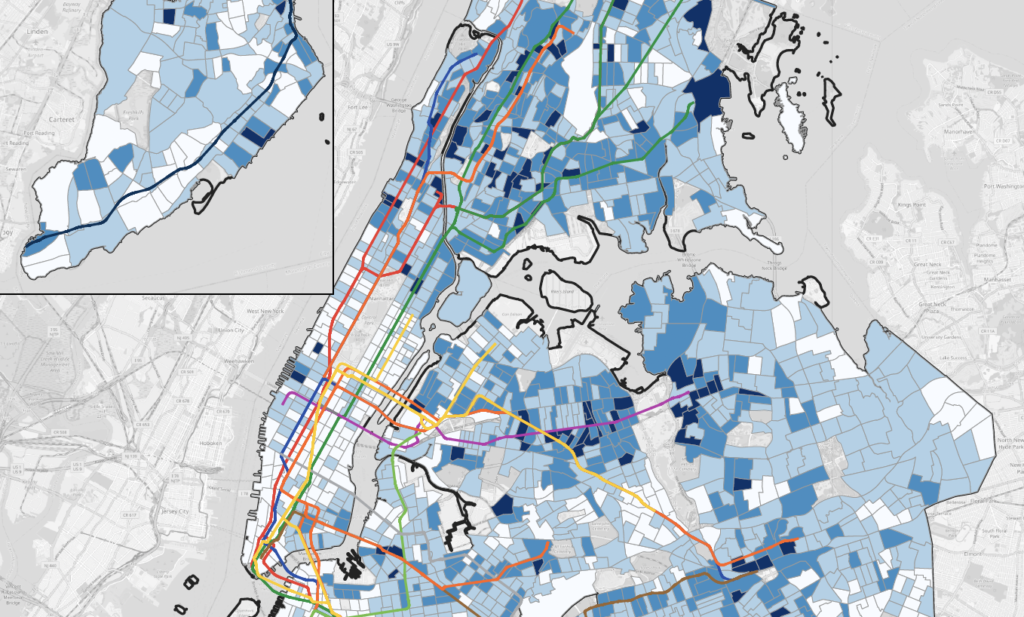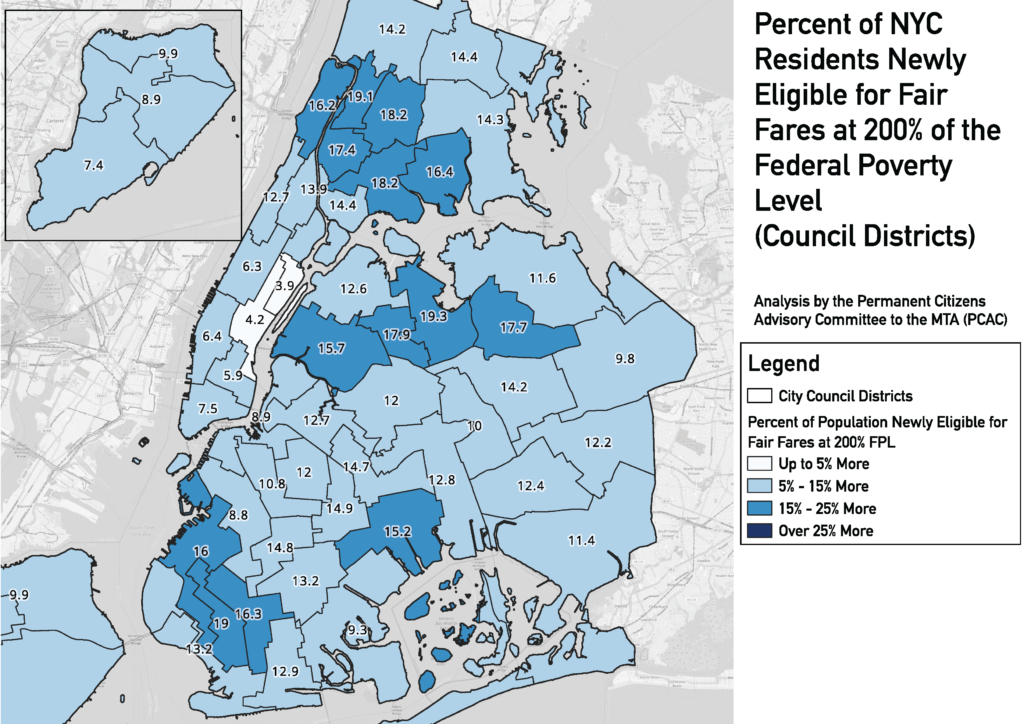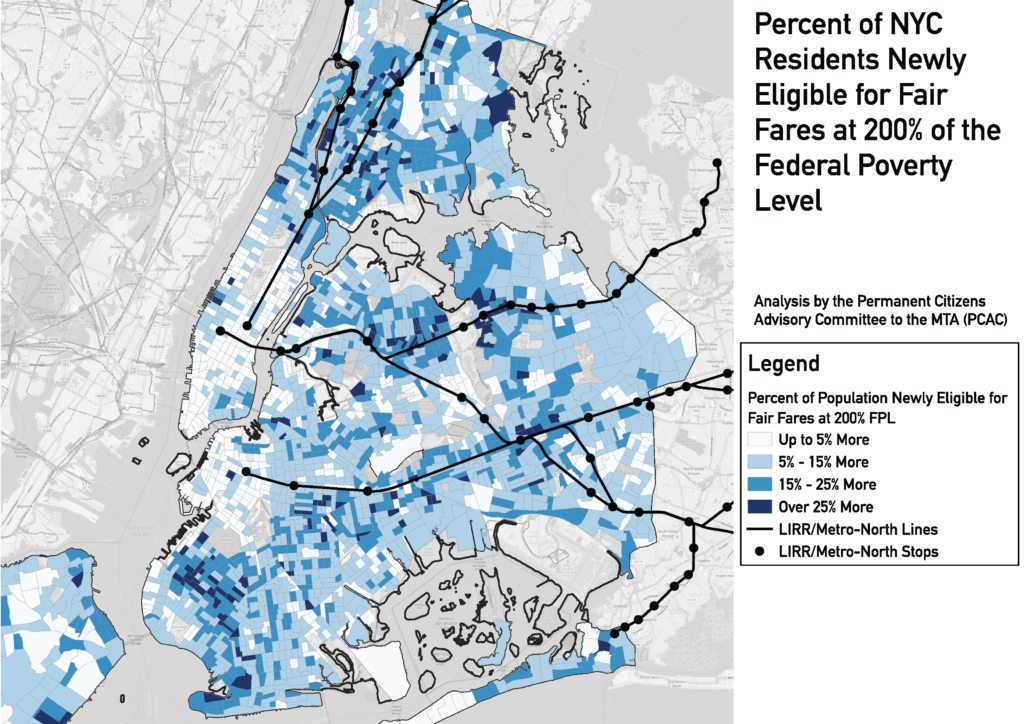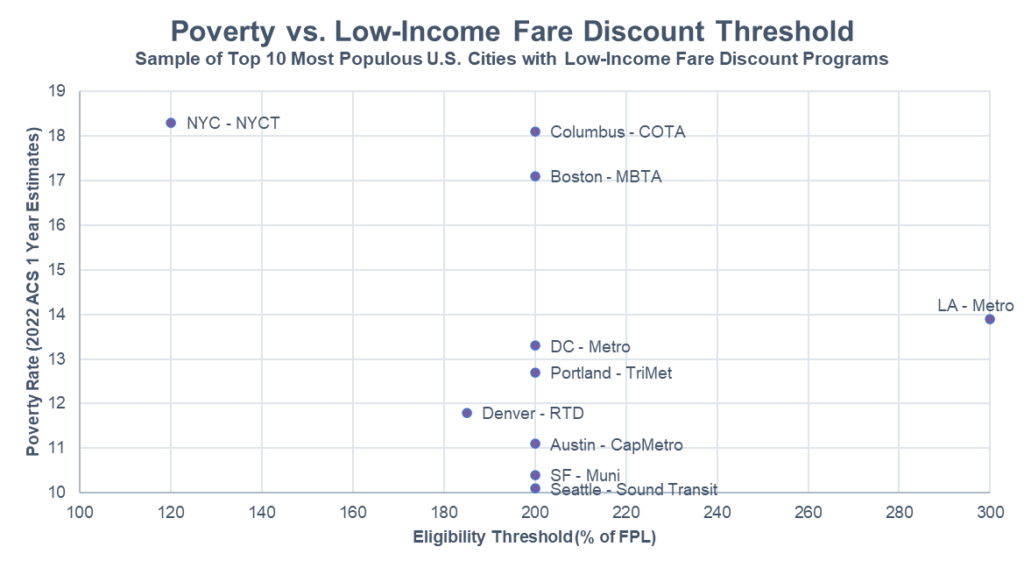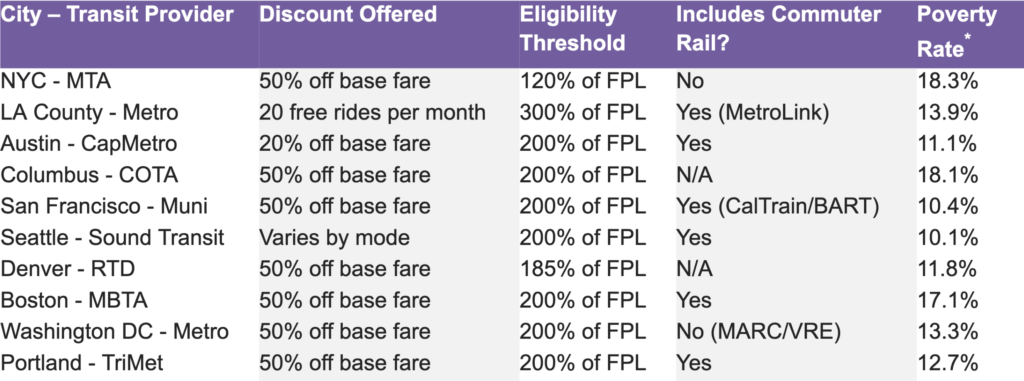Making Fair Fares More Fair for More People
Since its launch in 2019 and expansion in 2023, the Fair Fares program has proven to be a lifeline for nearly 325,000 New York City residents living at 120% of the federal poverty level (FPL) or below. This program, which allows working-age adults (aged 18-64) to access half-price MetroCards for New York City Transit’s subway and bus network, has been instrumental in providing affordable transportation options to those in need. Access to half-price fares is a game changer for low-income New Yorkers, but far too few qualify at its current eligibility threshold.
The program must be expanded to 200% of FPL to serve the communities—particularly the working poor living paycheck-to-paycheck or making minimum wage—that need relief in their transportation budgets to make their commutes more affordable. The program’s expansion would make more than 650,000 additional New Yorkers eligible, up from approximately 950,000 who are eligible for Fare Fares today. However, only about 34% of eligible residents are currently enrolled in the program. While increasing participation in the program has been a goal of MTA, city, and NYPD staff, they have achieved only limited success.
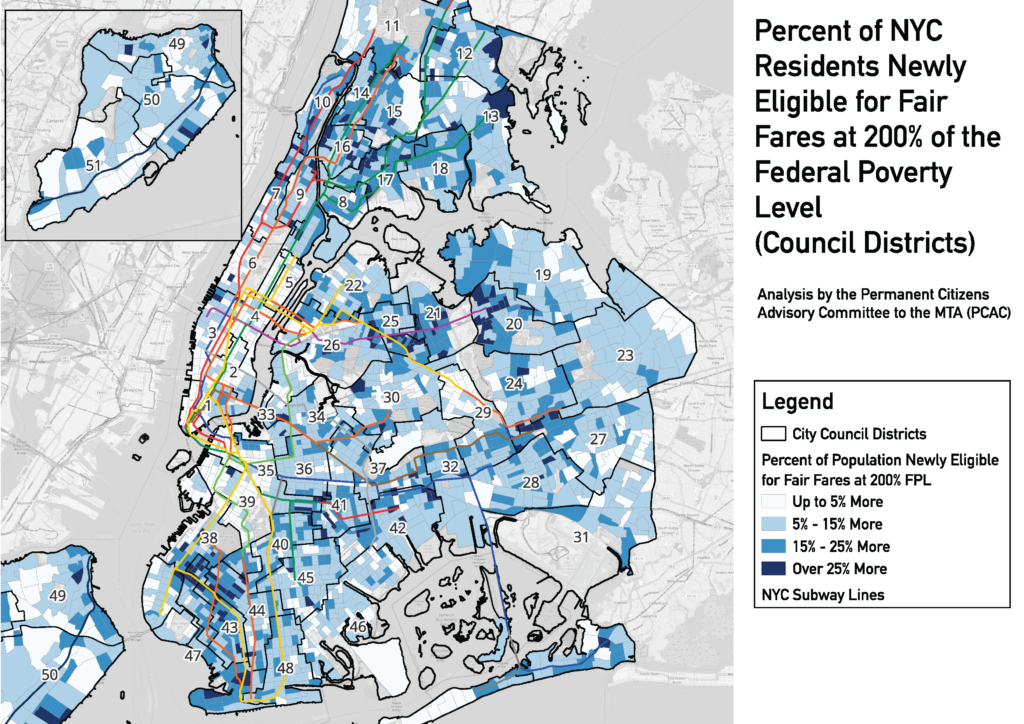
PCAC, in collaboration with the Community Service Society (CSS) and Riders Alliance, has tirelessly advocated for the much-needed expansion of the Fair Fares program through research, op-eds, and campaigns to support the expansion to 200% of FPL. This city-funded program would require approximately $55M million a year in funding, per CSS analysis.
PCAC has also advocated expanding Fair Fares to the LIRR and Metro-North within New York City so that low-income riders can afford faster trips on the commuter railroads. That change would be particularly impactful for areas of Southeast and Northeastern Queens, the Central and Western Bronx, and, eventually, the Eastern Bronx after the completion of four new Metro-North stations that will be constructed as part of the Penn Station Access project.
As noted in the 2023 Blue-Ribbon Panel on fare evasion report, the program is also a critical tool to make subways and buses more equitable. Key to improving its reach, the panel recommended raising the income eligibility threshold to 200% of FPL. They also encouraged the MTA and NYPD to increase education efforts about the program and give fare evaders an opportunity to enroll in Fair Fares and have their summons dismissed should they qualify; legislation to this effect was included in the FY24-25 enacted New York State budget. The report states: “From a fare evasion perspective, this expansion of Fair Fares would be a significant win-win.” Additionally, they note that much more needs to be done to educate eligible residents about the program and also steps that could be taken to make the program easier to access.
PCAC analyzed how an expansion of Fair Fares to 200% FPL would look geographically and which boroughs and city council districts would see the greatest increase in eligible residents. PCAC used American Community Survey data from 2017-2021 broken down by census tract to estimate the impact of the expansion, adjusting the numbers to exclude residents younger than 18 or older than 64. Still, the numbers provided very likely represent the high end of a reasonable estimate range due to a decrease in total population for New York City since the ACS data used was released and our inability to subtract riders who may qualify for other discounts or programs that would preclude them from qualifying for the Fair Fares program.
Key Findings of Expansion to 200% FPL:
- Well over 650,000 residents will become eligible for the program, including over 250,000 regular commuters.
- Every City Council district has at least one census tract in its district where the percentage of residents eligible for Fair Fares will increase by at least 10%.
- The Bronx will see the greatest per capita increase as an additional 16.2% of the population will become eligible for Fair Fares. Queens and Brooklyn are second and third at 13.2 and 13.1% respectively.
- Brooklyn will see the greatest increase in total population over those now eligible for Fair Fares at nearly 218,000 people, followed by Queens at 197,000, the Bronx at 141,000, Manhattan at 101,000, and Staten Island at 27,000
- An expansion of the program would have the greatest impact on working-class neighborhoods, including Sunset Park, Brownsville, Flushing, Elmhurst/Jackson Heights, Morrisania, and Highbridge.
- Beyond the Central Business District, there is a strong correlation between areas where fare evasion summonses are most prevalent and areas that will see the greatest increase in newly eligible Fair Fares riders.
- Nationally, New York’s Fair Fares program has the most restrictive income requirements despite being the metro with the highest cost of living and having the highest poverty rates of major cities with comparable programs.
- Expansion of the Fair Fares program to LIRR and Metro-North trains within New York City would expand access to a significant number of residents below 200% of poverty, especially in portions of the Bronx and Queens that do not have easy subway access. 70% of city LIRR and Metro-North stations are close to communities where over a quarter of residents would qualify for Fair Fares.
Slide the map below to see how many more neighborhoods would benefit from a higher Fair Fares eligibility threshold!
Figure 2 (Before): Concentration of NYC Residents Who Currently Qualify for Fair Fares at 125% FPL* vs. Figure 3 (After): Concentration of NYC Residents Who Would Qualify for Fair Fares at 200% FPL
*Note: Maps regarding change in Fair Fares eligibility use 125% of the Federal Poverty Level as a proxy for 120% of the Federal Poverty Level, due to the categorization used by the ACS and NHGIS in the dataset.
Where Residents Will Benefit from Fair Fares Expansion
An expansion of the Fair Fares program from 120% to 200% of FPL will not be equally distributed across the city. Neighborhoods such as Sunset Park, Brownsville, Flushing, Elmhurst/Jackson Heights, Morrisania, and Highbridge will see considerable increases in the number of residents that will be newly eligible for Fair Fares, while wealthier neighborhoods, including many neighborhoods in Manhattan, will see far more modest increases.
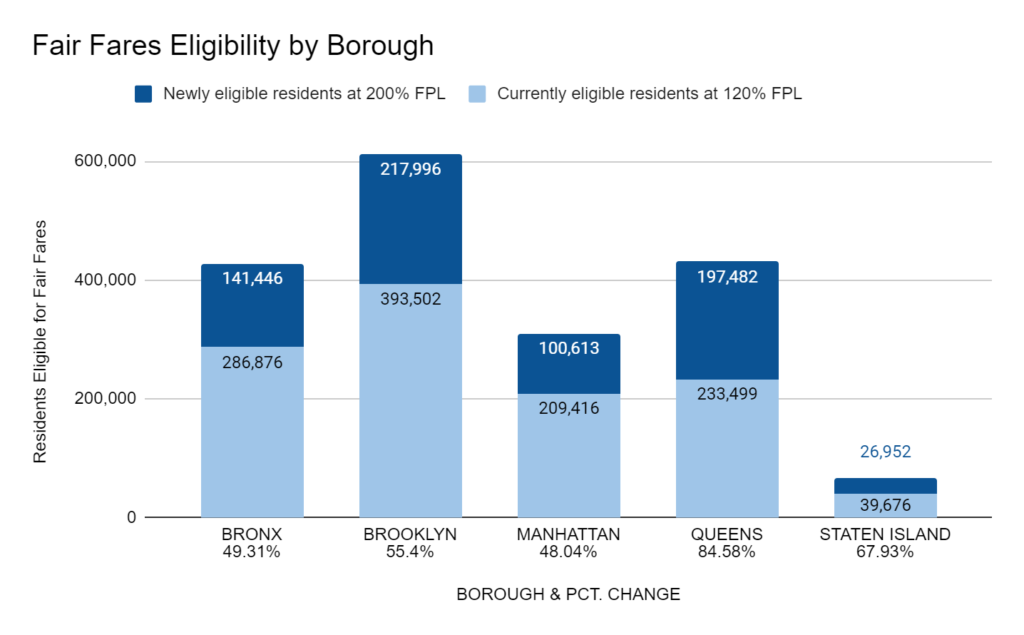
Looking at a borough-level breakdown, The Bronx will see the greatest per capita increase as an additional 16.2% of the total population will become eligible for Fair Fares, while Queens and Brooklyn are second and third at 13.2 and 13.1% respectively. Queens will see the greatest percentage increase in residents eligible for Fair Fares, with an 85% increase. Staten Island will see a 68% increase in eligible residents, while the other boroughs hover around 50% increases. Brooklyn will see the greatest increase in total population now eligible for Fair Fares at nearly 218,000 people, followed by Queens at 197,500, the Bronx at 141,400, Manhattan at 100,600, and Staten Island at almost 27,000.
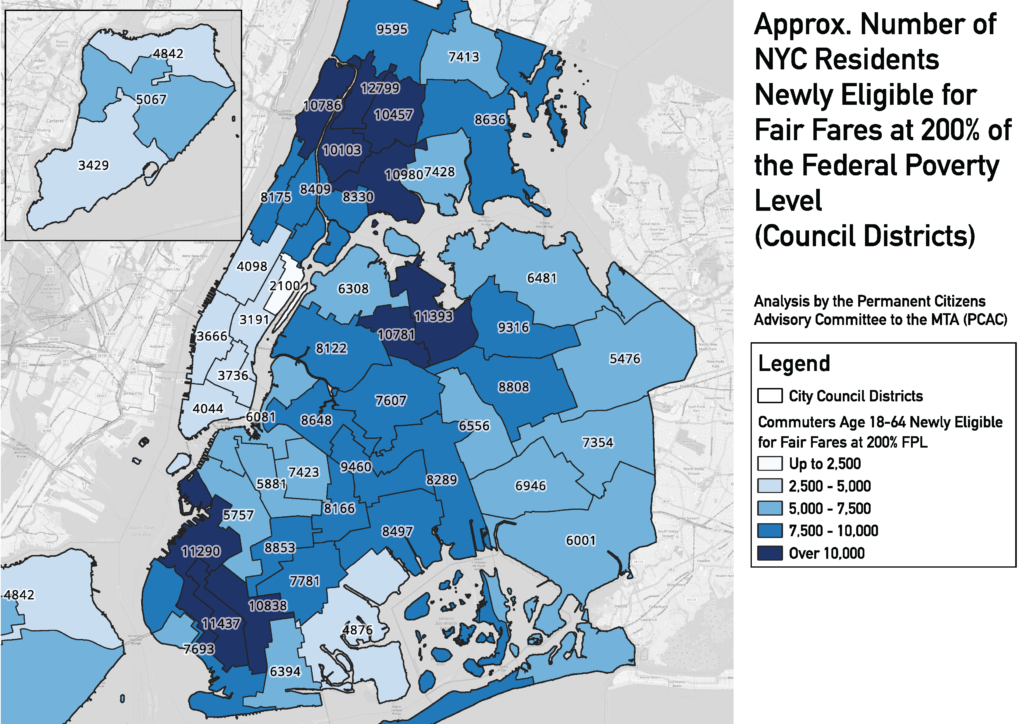
As referenced in Figure 5 above, in terms of the raw population eligible for the program, District 14 in the Bronx, represented by Councilmember Pierina Ana Sanchez, will see the greatest total increase in residents eligible for Fair Fares, with approximately 52,455 residents newly eligible for the program, 12,000 of whom are regular commuters. The greatest change in eligible residents for the program (Figure 6), however, belongs to District 21 in Central Queens, represented by Councilmember Francisco Moya, who will see 19.3% of the total population of that district become newly eligible for Fair Fares — before construction of the new Willets Point development.
Eligible commuting population was calculated by estimating that 40% of the 18–64-year-old population in each district will need to regularly commute, according to estimates by the Community Service Society.
The map below shows how the expansion of the Fair Fares program to LIRR and Metro-North trains within New York City would expand access to a significant number of residents below 200% of poverty, especially in portions of the Bronx and Queens that do not have easy subway access. 70% of city LIRR and Metro-North stations are close to communities where over a quarter of residents would qualify for Fair Fares, with stations near the suburbs and the three commuter terminals representing the vast majority of the stations where residents are more affluent. An expansion of Fair Fares to LIRR and Metro-North would be a boon for transportation equity in the city and is estimated by PCAC to initially cost approximately $5 million annually, a price tag that could easily be paid for by New York City—in keeping with the current precedent for Fair Fares funding.
Fare Evasion and Fair Fares
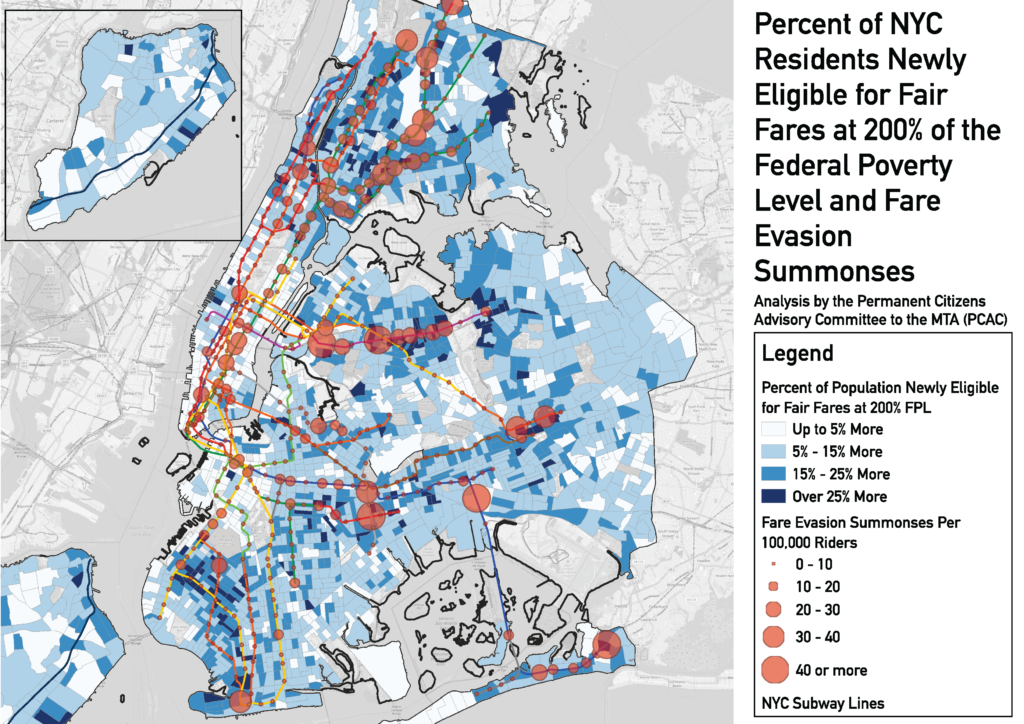
*Fare evasion summons data was compiled by Gothamist from January through September 2023 using NYPD and MTA data. Data excludes Staten Island Railway stations.
As noted in the 2023 Blue-Ribbon Panel on fare evasion report, the Fair Fares program is also a critical tool to make subways and buses more equitable. The map above shows a strong correlation between areas where fare evasion is known to be prevalent based on the number of fare evasion summonses per 100,000 riders and areas that would see large increases in residents eligible for Fair Fares if the threshold for eligibility was raised to 200% FPL, while the map below shows the total percentage of the population eligible for Fair Fares and its strong correlation to fare evasion summonses.
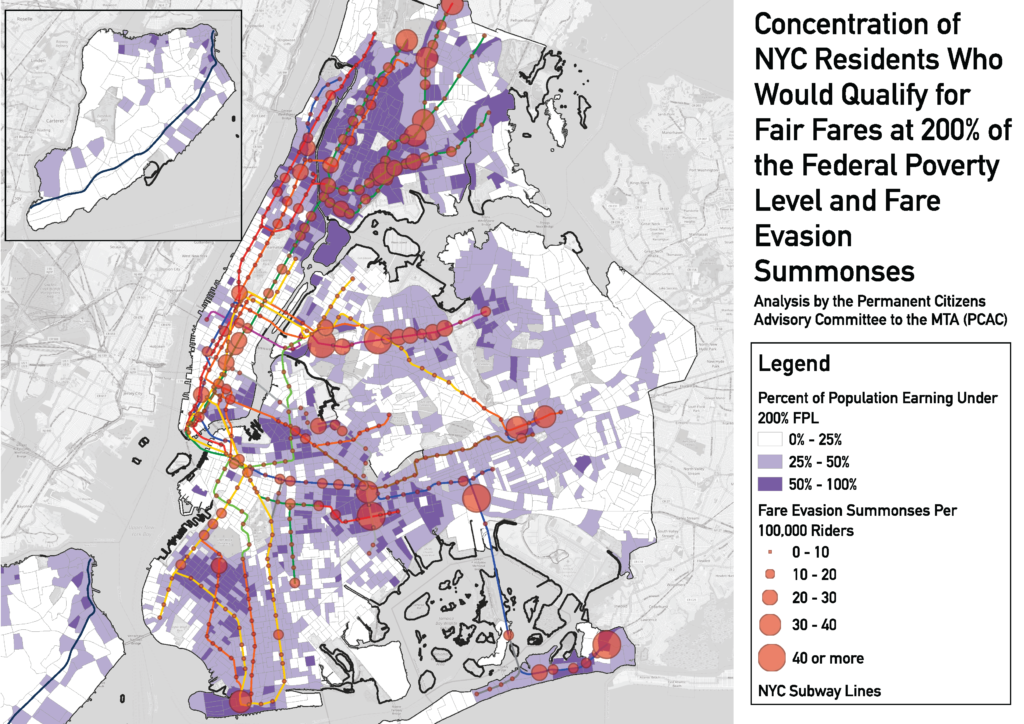
The panel recommended raising the income eligibility threshold to 200% of FPL. They also encouraged the MTA and NYPD to increase education efforts about the program and give fare evaders an opportunity to enroll in Fair Fares and have their summons dismissed should they qualify. The report states: “From a fare evasion perspective, this expansion of Fair Fares would be a significant win-win.” Additionally, they note that much more needs to be done to educate eligible residents about the program and also steps that could be taken to make the program easier to access.
Note that only subway evasions are shown here, as stop-level bus and Staten Island Railway data on fare evasion was not immediately available.
National Context
PCAC analyzed transit providers in the top ten most populous cities in the United States with income-based fare discount programs and found that New York City has both the highest poverty rate and the lowest income threshold at just 120% of the Federal Poverty Level. These results show that the industry standard is to offer a 50% discount to riders making up to 200% of the Federal Poverty Level.
After New York City, the next lowest threshold is Denver’s RTD, whose “LiVE” income-based fare discount program has a threshold at 185% of the Federal Poverty Level. The most generous income-based fare discount in terms of the discount offered also has the highest eligibility: Los Angeles County, which offers 20 free rides per month to Angelenos who make up to 300% of the Federal Poverty Level.
*2022 American Community Survey 1-Year Estimates
Of the ten cities analyzed, eight have commuter rail systems operating in the same jurisdiction. Of those, six provide income-based fare discounts on commuter rail and two, New York City and Washington D.C., do not. Unlike the MTA, which oversees New York City Transit, the LIRR, and Metro-North, Washington D.C.’s Metro does not manage the city’s commuter rail services, Maryland Area Rail Commuter (MARC) and Virginia Railway Express (VRE). MARC has one stop within DC city limits, Union Station, and VRE has two. The LIRR and Metro-North have a combined 39 commuter rail stations within New York City.
Conclusion
The data shows that expanding Fair Fares eligibility would be a game changer for New Yorkers around the five boroughs. Increasing access to transit by reducing the fare for so many low and low-to-middle- income riders means increasing access to opportunity. Further expanding the Fair Fares program to include the LIRR and Metro-North within New York City—at 200% of the Federal Poverty Level—will help ensure that more riders can afford faster trips on the commuter rail lines that run through Brooklyn, the Bronx, Queens, and Upper Manhattan. The City Council has already shown support for expanding the Fair Fares program to 200% of the Federal Poverty Level—now, riders are depending on Mayor Adams to come to the table and commit to expanding Fair Fares eligibility in this year’s City budget.
Methodology
Our maps use the 2017-2021 Five-Year Average American Community Survey (ACS) data compiled for GIS by IPUMS National Historical Geographic Information System. Maps regarding change in Fair Fares eligibility use 125% of the Federal Poverty Level as a proxy for 120% of the Federal Poverty Level, due to the methodology used by the ACS and NHGIS in table C17002: Ratio of Income to Poverty Level in the Past 12 Months. Because of the high cost of living in New York City, the number of people making between 120% and 125% of the Federal Poverty Level is considered negligible for this analysis and only adds to the total number of people who would be newly eligible for Fair Fares.
Sources
Debipriya Chatterjee and Emerita Torres. Community Service Society. When You Can’t Afford the Fare. New York, NY. 2024. https://smhttp-ssl-58547.nexcesscdn.net/nycss/images/uploads/pubs/031324_UHT2023_Transit_Brief_V6.pdf
Steven Manson, Jonathan Schroeder, David Van Riper, Katherine Knowles, Tracy Kugler, Finn Roberts, and Steven Ruggles. IPUMS National Historical Geographic Information System: Version 18.0 [dataset]. Minneapolis, MN: IPUMS. 2023. http://doi.org/10.18128/D050.V18.0
